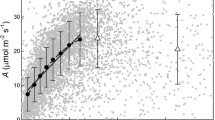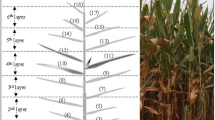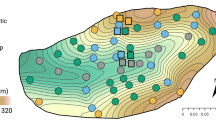Abstract
Analytical Lagrangian equations capable of predicting concentration profiles from known source distributions offer the opportunity to calculate source/sink distributions through inverted forms of these equations. Inverse analytical Lagrangian equations provide a practical means of estimating source profiles using concentration and turbulence measurements. Uncertainty concerning estimates of the essentially immeasurable Lagrangian length scale (\({\mathcal{L}}\)), a key input, impedes the operational practicality of this method. The present study evaluates \({\mathcal{L}}\) within a corn canopy by using field measurements to constrain an analytical Lagrangian equation. Measurements of net CO2 flux, soil-to-atmosphere CO2 flux, and in-canopy profiles of CO2 concentration provided the information required to solve for \({\mathcal{L}}\) in a global optimization algorithm for 30-min time intervals. For days when the canopy was a strong CO2 sink, the optimization frequently located \({\mathcal{L}}\) profiles that follow a convex shape. A constrained optimization then fit the profile shape to a smooth sigmoidal equation. Inputting the optimized \({\mathcal{L}}\) profiles in the forward and inverse Lagrangian equations leads to strong correlations between measured and calculated concentrations and fluxes. Coefficients of the sigmoidal equation were specific to each 30-min period and did not scale with any measured variable. Plausible looking \({\mathcal{L}}\) profiles were associated with negative bulk Richardson number values. Once the canopy senesced, a simple eddy diffusivity profile sufficed to relate concentrations and sources in the analytical Lagrangian equations.
Similar content being viewed by others
References
Amiro BD, Barr AG, Black TA, Iwashita H, Kljun N, McCaughey JH, Morgenstern K, Murayama S, Nesic Z, Orchansky AL, Saigusa N (2006) Carbon, energy, and water fluxes at mature and disturbed forest sites, Saskatchewan, Canada. Agric For Meteorol 136: 237–251
Aster RC, Borchers B, Thurber CH (2005) Parameter estimation and inverse problems, international geophysics series. Elsevier Academic Press, Burlington MA, USA, 320 pp
Aubinet M, Vesala T, Papale D (eds.): 2012, Eddy covariance: a practical guide to measurement and data analysis. Springer, 438 pp
Baldocchi D (1992) A Lagrangian random-walk model for simulating water vapor, CO2 and sensible heat flux densities and scalar profiles over and within a soybean canopy. Boundary-Layer Meteorol 61: 113–144
Baldocchi D (2003) Assessing the eddy covariance technique for evaluating carbon dioxide exchange rates of ecosystems: past, present and future. Glob Change Biol 9(4): 479–492
Coppin PA, Raupach MR, Legg BJ (1986) Experiments on scalar dispersion within a model plant canopy part II: an elevated plane source. Boundary-Layer Meteorol 35: 167–191
Corrsin S (1963) Estimates of the relations between Eulerian and Lagrangian scales in large Reynolds number turbulence. J Atmos Sci 20: 115–119
Corrsin S (1974) Limitations of gradient transport models in random walks and in turbulence. In: Frenkiel FN, Munn RE, Landsberg HE, van Mieghem J (eds) Turbulent diffusion in environmental pollution, vol 18. New York, USA, p. 25–60, Academic Press Inc, 462 pp
Denmead OT, Bradley EF (1987) On scalar transport in plant canopies. Irrigation Sci 8(2): 131–149
Denmead OT, Harper L, Sharpe R (2000) Identifying sources and sinks of scalars in a corn canopy with inverse Lagrangian dispersion analysis I. Heat. Agric For Meteorol 104: 67–73
Flesch TK, Wilson JD (1992) A two-dimensional trajectory-simulation model for non-Gaussian, inhomogeneous turbulence within plant canopies. Boundary-Layer Meteorol. 61: 349–374
Gifford FA (1955) A simultaneous Lagrangian–Eulerian turbulence experiment. Mon Weather Rev 85: 293–301
Hanna SR (1981) Lagrangian and Eulerian time-scale relations in the daytime boundary layer. J Appl Meteorol 20: 242–249
Hansen P (1994) Regularization tools: a Matlab package for analysis and solution of discrete ill-posed problems. Numer Algorithms 6: 1–35
Harper L, Denmead OT, Sharpe R (2000) Identifying sources and sinks of scalars in a corn canopy with inverse Lagrangian dispersion analysis II. Ammonia. Agric For Meteorol 104: 75–83
Haverd V, Cuntz M, Leuning R, Keith H (2007) Air and biomass heat storage fluxes in a forest canopy: calculation within a soil vegetation atmosphere transfer model. Agric For Meteorol 147(3–4): 125–139
Haverd V, Leuning R, Griffith D, van Gorsel E, Cuntz M (2009) The turbulent Lagrangian time scale in forest canopies constrained by fluxes, concentrations and source distributions. Boundary-Layer Meteorol 130(2): 209–228
Hay JS, Pasquill F (1959) Diffusion from a continuous source in relation to the spectrum and scale of turbulence. Adv Geophys 6: 345–365
Hunt JCR, Weber AH (1979) A Lagrangian statistical analysis of diffusion from a ground-level source in a turbulent boundary layer. Q J R Meteorol Soc 105: 423–443
Ingber L (1996) Adaptive simulated annealing (ASA): lessons learned. Control Cybern 25: 33–54
Katul G, Oren R, Ellsworth D, Hsieh CI, Phillips N (1997) A Lagrangian dispersion model for predicting CO2 sources, sinks, and fluxes in uniform lobolly pin (Pinus taeda L.) stand. J Geophys Res 102(D8): 9309–9321
Kirkpatrick S, Gelatt CD, Vecchi MP (1983) Optimization by simulated annealing. Science 220(4598): 671–680
Leuning R, Denmead OT, Miyata A, Kim J (2000) Source/sink distributions of heat, water vapour, carbon dioxide and methane in a rice canopy estimated using Lagrangian dispersion analysis. Agric For Meteorol 104: 233–249
Massman WJ, Weil JC (1999) An analytical one-dimensional second-order closure model of turbulence statistics and the Lagrangian time scale within and above plant canopies of arbitrary structure. Boundary-Layer Meteorol 91(1): 81–107
Menke W (1989) Geophysical data analysis: discrete inverse theory. Academic Press Inc, San Diego, USA, 289 pp
Molder M, Klemedtsson L, Lindroth A (2004) Turbulence characteristics and dispersion in a forest—tests of Thomson’s random-flight model. Agric For Meteorol 127(3–4): 203–222
Nemitz E, Sutton MA, Gut A, Jose RS, Husted S, Schjoerring JK (2000) Sources and sinks of ammonia within an oilseed rape canopy. Agric For Meteorol 105(4): 385–404
Philip JR (1967) Relation between Eulerian and Lagrangian statistics. Phys Fluids 9(2): S69–S71
Poggi D, Porporato A, Ridolfi L, Albertson JD, Katul GG (2004) The effect of vegetation density on canopy sub-layer turbulence. Boundary-Layer Meteorol 111: 565–587
Qiu G, Warland J (2006) Inferring profiles of energy fluxes within a soybean canopy using Lagrangian analysis. Agric For Meteorol 139: 119–137
Raupach MR (1987) A Lagrangian analysis of scalar transfer in vegetation canopies. Q J R Meteorol Soc 113: 107–120
Raupach MR (1989a) Applying Lagrangian fluid mechanics to infer scalar source distributions from concentration profiles in plant canopies. Agric For Meteorol 47(2–4): 85–108
Raupach MR (1989b) A practical Lagrangian method for relating scalar concentrations to source distributions in vegetation canopies. Q J R Meteorol Soc 115(487): 609–632
Raupach MR, Coppin PA, Legg BJ (1986) Experiments on scalar dispersion within a model-plant canopy Part I: the turbulence structure. Boundary-Layer Meteorol 35: 21–52
Raupach MR, Finnigan JJ, Brunet Y (1996) Coherent eddies and turbulence in vegetation canopies: the mixing-layer analogy. Boundary-Layer Meteorol 78(3–4): 351–382
Rochette P, Bertrand N (2008) Soil sampling and methods of analysis, Chapt. 65, pp. 851–862. Taylor and Francis Group., Boca Raton, FL, 2nd ed. edition, 1264 pp
Santos E, Wagner-Riddle C, Warland J (2011) Applying Lagrangian dispersion analysis to infer carbon dioxide and latent heat fluxes in a corn canopy. Agric For Meteorol 151: 620–632
Santos E, Wagner-Riddle C, Lee X, Warland JS, Brown SE, Kim K (2012) Use of the isotope flux ratio approach to investigate the C18O16O and 13CO2 exchange near the floor of a temperatedeciduous forest. Biogeosciences 9: 2385–2399
Siqueira M, Lai CT, Katul GG (2000) Estimating scalar sources, sinks, and fluxes in a forest canopy using Lagrangian, Eulerian, and hybrid inverse models. J Geophys Res 105(D24), 29, 475–29, 488
Siqueira M, Leuning R, Kolle O, Kelliher FM, Katul GG (2003) Modelling sources and sinks of CO2, H2O and heat within a Siberian pine forest using three inverse methods. Q J R Meteorol Soc 129: 1373–1393
Styles JM, Raupach MR, Farquhar GD, Kolle O, Lawton KA, Brand WA, Werner RA, Jordan A, Schulzssssse ED, Shibistova O, Lloyd J (2002) Soil and canopy CO2, CO2−C13, H2O and sensible heat flux partitions in a forest canopy inferred from concentration measurements. Tellus B 54(5): 655–677
Tanner CB, Thurtell GW (1969) Aneclinometer measurements of Reynolds stress and heat transport in the atmosphere of the surface layer, final report. Technical Report TREMCOM 66-G22-F, University of Wisconsin, Madison, WI, USA
Tarantola A (2006) Popper, Bayes and the inverse problem. Nature 2: 492–494
Taylor GI (1921) Diffusion by continuous moments. P L Math Soc 20: 196
Tiwary A, Fuentes JD, Barr JG, Wang D, Colls JJ (2007) Inferring the source strength of isoprene from ambient concentrations. Environ Modell Softw 22(9): 1281–1293
van Gorsel E, Harman IN, Finnigan JJ, Leuning R (2011) Decoupling of air flow above and in plant canopies and gravity waves affect micrometeorological estimates of net scalar exchange. Agric For Meteorol 151: 927–933
Wagner-Riddle C, Thurtell GW, Kidd GK, Beauchamp EG, Sweetman R (1997) Estimates of nitrous oxide emissions from agricultural fields over 28 months. Can J Soil Sci 77(2): 135–144
Warland JS, Thurtell G (2000) A Lagrangian solution to the relationship between a distributed source and concentration profile. Boundary-Layer Meteorol 96(3): 453–471
Wilson JD, Ward DP, Thurtell GW, Kidd GE (1982) Statistics of atmospheric turbulence within and above a corn canopy. Boundary-Layer Meteorol 24(4): 495–519
Wilton M (2010) The use of natural abundance \({\delta^{13}{C}}\) to identify and quantify sources of emitted carbon dioxide in a calcareous southern Ontario Luvisolic soil. Ph.D. thesis, University of Guelph, Guelph, Ontario, 151 pp
Wohlfahrt G (2004) Modelling fluxes and concentrations of CO2, H2O and sensible heat within and above a mountain meadow canopy: a comparison of three Lagrangian models and three parameterisation options for the Lagrangian time scale. Boundary-Layer Meteorol 113(1): 43–80
Author information
Authors and Affiliations
Corresponding author
Rights and permissions
About this article
Cite this article
Brown, S.E., Warland, J.S., Santos, E.A. et al. Estimating a Lagrangian Length Scale Using Measurements of CO2 in a Plant Canopy. Boundary-Layer Meteorol 147, 83–102 (2013). https://doi.org/10.1007/s10546-012-9778-6
Received:
Accepted:
Published:
Issue Date:
DOI: https://doi.org/10.1007/s10546-012-9778-6




